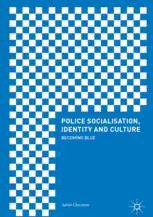
Police Socialisation, Identity and Culture: Becoming Blue PDF
Preview Police Socialisation, Identity and Culture: Becoming Blue
POLICE SOCIALISATION, IDENTITY AND CULTURE BECOMING BLUE Sarah Charman Police Socialisation, Identity and Culture Sarah Charman Police Socialisation, Identity and Culture Becoming Blue Sarah Charman University of Portsmouth Portsmouth, United Kingdom ISBN 978-3-319-63069-4 ISBN 978-3-319-63070-0 (eBook) DOI 10.1007/978-3-319-63070-0 Library of Congress Control Number: 2017953255 © The Editor(s) (if applicable) and The Author(s) 2017 This work is subject to copyright. All rights are solely and exclusively licensed by the Publisher, whether the whole or part of the material is concerned, specifically the rights of translation, reprinting, reuse of illustrations, recitation, broadcasting, reproduction on microfilms or in any other physical way, and trans- mission or information storage and retrieval, electronic adaptation, computer software, or by similar or dissimilar methodology now known or hereafter developed. The use of general descriptive names, registered names, trademarks, service marks, etc. in this publication does not imply, even in the absence of a specific statement, that such names are exempt from the relevant protective laws and regulations and therefore free for general use. The publisher, the authors and the editors are safe to assume that the advice and information in this book are believed to be true and accurate at the date of publication. Neither the publisher nor the authors or the editors give a warranty, express or implied, with respect to the material contained herein or for any errors or omissions that may have been made. The publisher remains neutral with regard to jurisdictional claims in published maps and institutional affiliations. Printed on acid-free paper This Palgrave Macmillan imprint is published by Springer Nature The registered company is Springer International Publishing AG The registered company address is: Gewerbestrasse 11, 6330 Cham, Switzerland To my mother, Liz Charman Acknowledgements This book and the research contained within it were inspired by a conver- sation with Superintendent RJ in what I have called ‘Evermord Constabulary’, who was intrigued by the changes which took place in new recruits to the police service within the first few years of their polic- ing careers. Thanks are due to him for planting that seed of a question which inspired the next four years of my academic research and for his continued support throughout that process. Thanks must clearly also go to the new recruits of Evermord Constabulary for putting up with four years of endless questions and getting very little chocolate by way of com- pensation. I promise to leave you in peace for at least a few years before I start knocking on the windows of your stations again. Also extending my gratefulness to Abi Stark (now at the University of Sheffield) and Dr Stephanie Bennett (University of Portsmouth) for their invaluable help with the quantitative data analysis—I may now be a convert! Many thanks to Steve for reading through all of the drafts of the man- uscript, often at very short notice, and for wisely only making polite sug- gestions. Many thanks too to the grammar queen that is my mother for reading the manuscript aloud to check for mistakes and for letting me know that I have more work to do on my prepositions! Thanks to Jo for the name of the force and, importantly, for the therapeutic games of squash. ‘Thanks’ might be the wrong word for the contribution of Dan and Jacob because, as teenagers, their job description states that they vii viii Acknowledgements must do nothing at all to help and simply be an enormous source of dis- traction! Nonetheless, they remain the most joyous and the most inspir- ing part of my life, so for that, yes, thanks. Contents 1 Introduction 1 Part I Interpreting Police Socialisation, Identity and Culture 11 2 Organisational Culture and the Policing Organisation 13 3 Social, Personal and Group Identity 39 4 Training and Education in Policing 63 5 Learning to Become a Police Officer: Police Socialisation 91 6 Being a Police Officer: Policing Cultures 127 Part II R esearching Police Socialisation, Identity and Culture 169 ix x Contents 7 The Research: Aims and Methods 171 8 Quantitative Results: Measuring Attitudes, Measuring Change 189 9 Qualitative Findings I: Learning to Be a Cop 223 10 Qualitative Findings II: Becoming and Being a Cop 251 11 Qualitative Findings III: Contemporary Policing Challenges 289 12 C onclusion: Reconceptualising Policing Cultures 317 Appendix 1 345 References 355 Index 383 List of Figures Fig. 8.1 Most important priorities of a police officer—lower numbers reflect higher priority 191 Fig. 8.2 Most important characteristics of a police officer— lower numbers reflect higher priority 193 Fig. 8.3 Most important influences upon a police officer according to new recruits—lower numbers reflect higher priority 195 Fig. 8.4 Most important influences upon a police officer according to tutors—lower numbers reflect higher priority 196 Fig. 8.5 Most important influences upon a police officer according to student development recruitment officers—lower numbers reflect higher priority 198 Fig. 10.1 Do you feel like a police officer? 257 Fig. 10.2 What is the role of the police? 262 Fig. 12.1 The square of police learning 320 xi
